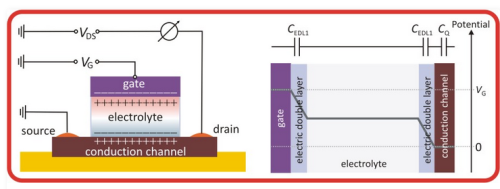Carbon Transistor

Electrolytically gated carbon field-effect transistor as bioelectronic sensor and interface
At the Institute of Physics of the Kazimierz Wielki University in Bydgoszcz, research has been undertaken on the construction of electrolytically gated field-effect transistors (SGFETs), in which the conducting channel is made of carbon materials. Both carbons with sp3 hybridization (diamond) and carbons with a honeycomb structure (nanotubes, graphene, graphene oxide, etc.) are taken into account. So far, it has been possible to implement a pH sensor based on a thin layer of hydrogenated diamond and paper made of single-walled carbon nanotubes (bucky-paper).
The electrolytically gated field-effect transistor (SGFET) consists of three electrodes (source, drain and gate) and a thin conduction channel which is a semi-conducting material. The source is grounded while two different voltages are applied to the drain and gate. The conductive channel and gate are separated from each other by an electrolyte that replaces the dielectric layer used in traditional field effect transistors. The gate voltage controls the conductivity of the semiconductive layer by changing the concentration of current carriers in the conduction channel.
Since the concentration of current carriers also changes under the influence of electroactive ions from the solution adsorbed on the surface of the semiconductor, SGFET is used as a chemical and biological sensor to measure the pH of the solution, Na+, K+, Ca2+, Mg2+, Pb2+ ions and biological analytes [Feng Yan, Meng Zhang , and Jinhua Li. Adv. Healthcare Mat. 2014, DOI: 10.1002/adhm.201300221]. Application of this type of transistor in bioelectronics is also considered. This device can play the role of an interface (neuroprosthesis) between the biological system, eg the retina in the eye, and standard microprocessors [Lucas H. Hess, Max Seifert, Jose A. Garrido. Proceedings of the IEEE. 2013, 101, 1780, DOI: 10.1109/JPROC.2013.2261031].
Materials used as a conductive channel in a transistor are often unstable in aqueous solutions, which contributes to a decrease in the sensitivity of SGFET sensors in living tissues. In order to ensure a good signal-to-noise ratio, chemically resistant materials should be used, which at the same time exhibit high charge mobility. Carbon materials largely meet these expectations, are biocompatible and chemically stable in aqueous electrolytes. The problem we are working on is to determine the influence of (1) the electronic structure of carbon materials with sp3 and sp2 hybridization, (2) the mobility of electrons and holes, and (3) the structure of the interface surface of the electrolyte and the SGFET conducting channel. We invite you to cooperate.
Contact: Paweł Szroeder, e-mail: psz@ukw.edu.pl Institute of Physics, Kazimierz Wielki University in Bydgoszcz